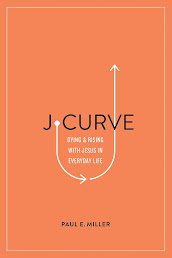In J-Curve, Paul Miller argues that "the normal Christian life repeatedly re-enacts the dying and rising of Jesus. I call it the J-Curve because, like the letter J, Jesus's life first went down into death, then up into resurrection." Though Jesus (and His J-Curve) was of course unique, "we have multiple J-Curves that echo his." Each has "their own unique cadences, but they all
- enter some kind of suffering in which evil is weakened or killed;
- weaken the flesh and form us into the image of Jesus;
- lead to a real-time, present resurrection."
The main message of the book is "see Jesus in his humility; don't run from his path of weakness." Miller's "goal is to draw you . . . into the dying and rising of Jesus- to reset your sense of the normal Christian life, freeing you from cynicism and despair. Inhabiting the J-Curve promises to transform your entire vision of how you engage life, freeing you from the world of resentment, touchiness, and just plain old grumpiness, and inviting you into Jesus's world, a world rich with joy, hope, and love." The concept of the J-Curve is prevalent throughout the Scriptures, to include "Philippians, 1 and 2 Corinthians, Romans 6 and 8, Colossians 1 and 3, and Ephesians 1 . . ." This book explores many of those passages and unpacks them.
Our human tendency is to operate on what Miller calls the "failure-boasting chart," where our confidence is in ourself and our boasting in our strengths. Even Christians- who should know better- fall into this trap, and the related idea of seeking prosperity (which generally means comfort, riches, or success) above all things. And yet, the gospel message is quite different:
Have this mind among yourselves, which is yours in Christ Jesus, who, though he was in the form of God, did not count equality with God a thing to be grasped, but emptied himself, by taking the form of a servant, being born in the likeness of men. And being found in human form, he humbled himself by becoming obedient to the point of death, even death on a cross. Therefore God has highly exalted him and bestowed on him the name that is above every name, so that at the name of Jesus every knee should bow, in heaven and on earth and under the earth, and every tongue confess that Jesus Christ is Lord, to the glory of God the Father. (Philippians 2:5-11)Jesus laid down his rights and substituted himself for his people. Christians are called to do the same, not just believing the gospel (faith) but becoming like the gospel (love):
Then Jesus told his disciples, “If anyone would come after me, let him deny himself and take up his cross and follow me. For whoever would save his life will lose it, but whoever loses his life for my sake will find it. (Matthew 16:24-25)
"Just as Jesus substitutes himself for us, we substitute the pieces of our lives for others . . . when we understand that substitution is the heart of love, we see life through a different lens." For us fallen humans, this takes the form of three J-curves:
- "In the love J-Curve, you pursue a problem outside of yourself. Love leads you to go after evil, to absorb pain.
- In the suffering J-Curve, evil comes at you from the outside, unwanted and unasked.
- In the repentance J-Curve, evil is in you. You're the problem. You cause the pain."
In each case, there will be a descent/death followed by a rising. It may not be fast or easy, but "this is the way" (to quote The Mandalorian). Of course, we have multiple J-Curves (of differing magnitudes and durations) operating and intersecting at a given time, both in ourselves and in the communities in which we find ourselves. The book unpacks these concepts from various angles.
Review
We're working through this book in our Sunday school class, which is why it took me six months to read. The message is outstanding and much needed (by me personally and society at large). Laying down my rights is never fun or easy- after all, they're my rights!- but it is key. This has helped me through several ongoing problems in my life, for which I'm thankful. So the content of the book is great. The presentation is varied- some chapters are amazing and well-structured, others were haphazard and disorganized. The book needs an editor . . . but that aside, well worth your time. Highly recommended.
Rating: A


No comments:
Post a Comment